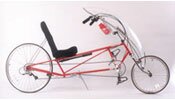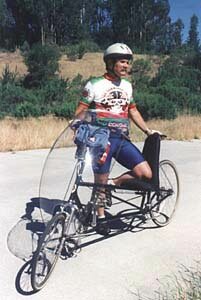

|
Sample Article Hey, How Are Those Things On Hills?
What's Possible Climbing Technique Lastly, it is important to know when to back off. If the road goes up over a long 10% grade, the wedgies will drop you. Look at your heart rate monitor, back off and live to fight (or catch up) another day. Equipment Mine are about the same, with aerodynamics playing a part as well. It is really difficult to push hard or even keep going if you hurt. Make sure everything is comfortable and fits right. Make sure your equipment is strong. When something breaks out on the road, it can take a long time to get rolling again. Many would argue that weight should rank number 1 or 2, but I agree with Lon. You can't get up a hill fast, slow or otherwise, with a broken 150 gram pedal or potato chipped 850 gram racing wheel. Weight is important, but your equipment has to be strong enough to go the distance. My own choice is LWB (long wheelbase) for comfort on rough roads, and because it is fast. It has to have ASS (above seat steering) so I can hang water bottle cages and computer mounts easily. It should have a comfortable seat. I prefer non-mesh so I can push hard against the seat back. On my Gold Rush Replica, everything is stock except the pedals and gearing. I use Shimano SPuD's (clipless) with the rotational cleats. In front I've swapped the stock chainrings for a 24/40/56 T. setup and in back an 11-28 cassette cluster. This gives me a 23-135 gear-inch range. If I feel the need to go faster, I switch to a lighter more aero set of wheels. That's it....no titanium anything. Training So, how are those things on hills? In my opinion, pretty damn good. With the right recumbent, lots of practice and training you can learn to keep the wedgies in sight on ascents and catch and pass them on any other kind of road. |
||||||||||||||||||||
|
||||||||||||||||||||
 I like to climb. The longer, the steeper, the better I like it. No, I'm not into masochism, it's just that in order to ride around hilly Santa Cruz County, where I live, you have to be able to climb to go anywhere. When I first started riding recumbents, I found hills to be formidable barriers that left me sucking big air, while watching wedgies disappear. Since that time, I have learned to get over the hills almost as fast as the wedgies so that downhill advantage is not wasted.
I like to climb. The longer, the steeper, the better I like it. No, I'm not into masochism, it's just that in order to ride around hilly Santa Cruz County, where I live, you have to be able to climb to go anywhere. When I first started riding recumbents, I found hills to be formidable barriers that left me sucking big air, while watching wedgies disappear. Since that time, I have learned to get over the hills almost as fast as the wedgies so that downhill advantage is not wasted.